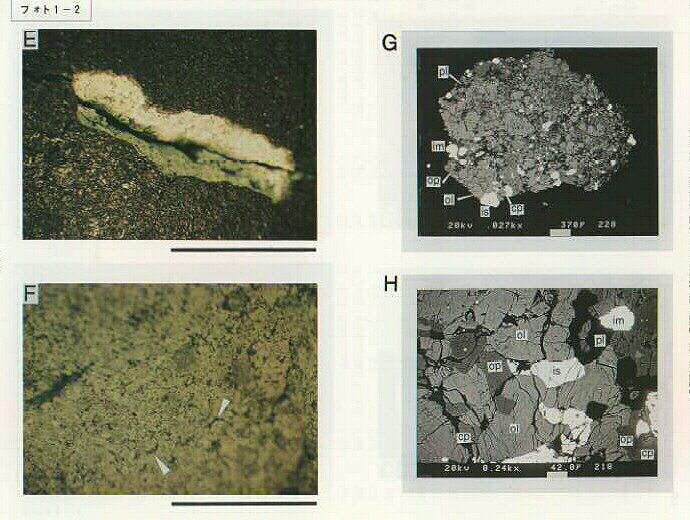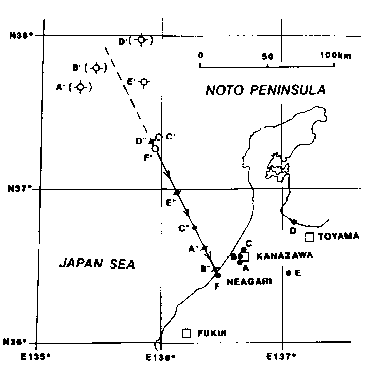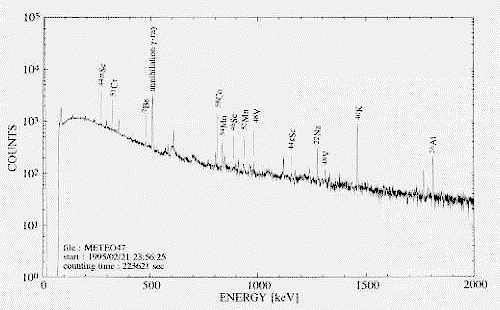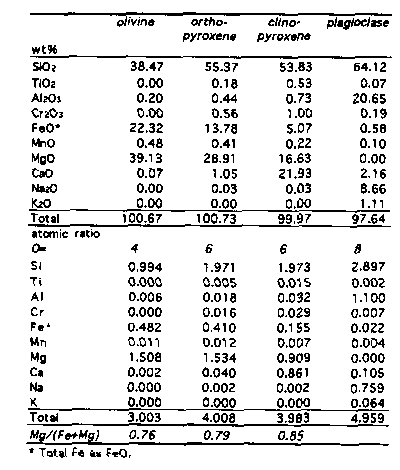
Neagari Meteorite Page
A preliminary report on the
Neagari meteorite fall on February 18th, 1995.
Akira Ishiwatari*, Keiichi Sasatani**, Kazue Tazaki*, Koh Sakamoto+, Takashi Nakanishi+, Kazuhisa Komura++, Tatsuki Tsujimori*, Yasuji Oura+, Yutaka Miyamoto+, Hisatada Akahane#, Makoto Watanabe# and Katsushi Nunomura#
This article was published in "Earth Science (Chikyu Kagaku)", vol. 49, no. 3, 179-182 (1995). Photographs and Japanese version appeared in the previous issue (vol. 49, no. 2, 71-76) of the same journal. The Journal is published by the Association for the Geological Collaboration in Japan ("Chidanken"), Kawai Bldg. 5F, Minami Ikebukuro 2-24-1, Toshima-ku, Tokyo 171-0022.
Abstract
A stone
meteorite was found by the second author (Sasatani) in a small
town near Kanazawa, central Japan, in the morning of Sunday,
February 19th, 1995. Place of finding is Ho-4, Taisei, Neagari
(pronounced neh-ah-gari) Town, Nomi County, Ishikawa Prefecture,
Japan (N36o6'57", E136o7'55"), and it is
named "Neagari Meteorite." The meteorite hit a car parked in
the central shopping district of the town (Photo A). Sasatani
started his car which was parked aside his house that morning,
and found that the rear trunk cover of his car flapped. He found
a black, rounded stone on the trunk cover, which was trapped in a
triangular hole at the center of the trunk cover.
The shape of the hole formed on the car indicates that the meteorite came from NNW direction (333o at an impact angle of 40o from the horizon (Photo B). Size and weight of the biggest fragment (presumably about 2/3 of the entity) are W6.5 x H4.0 x L6.0 cm (Length may have been 10 cm before crush) and 325 g, respectively. The meteorite is egg-shaped. Black glass crust, 1 mm thick, covers all over the surface. The interior is gray white, fine-grained rock (Photo C). There were three other major fragments (40, 30 and 18 g) and many tiny fragments in and outside the trunk. Weight of the collected fragments totals 420 g, but the original weight may have been about 500 g before crush. White paint fragments of the car are attached to the glass surface of the meteorite in a circular manner, suggesting that the meteorite rotated around its axis parallel to its flight direction when it hit the car (Photo D). However, the western side of the impact hole is bounded by a supporting pipe, and the shape of the hole is apparently controlled by this pipe (Photo B). It is also possible that the meteorite came from the north or northeast. The meteorite may have been prevented to pass through the trunk cover by the pipe and rotated toward northwest.
The precise
time of the hit is unknown, but a neighbour heard a big sound at
about 22:00 (JST: GMT+9) of Saturday, February 18th, 1995. The
discoverer did not notice this sound, though he was in bed in his
house at this time. On the other hand, five witnesses are so far
available in the Kanazawa-Toyama area for a fireball which
appeared in the northwestern sky, passing to the south (to the
left) (Fig. 1, Table 1). Three witnesses correspond with each
other in the time of appearance, which may be identified at about
23:55 of February 18th, 1995. The azimuth and elevation of the
fireball appearance from each witness site define a point where
the radial line reaches the height of 80 km from sea level, an
assumed height of fireball ignition. These points are distributed
in the area at about 100 km to the northwest of Noto Peninsula,
and the flight path of the meteorite restored from the shape of
the impact hole passes the area (Fig. 1). This suggests that the
fireball has been the Neagari meteorite itself.
The glassy surface is rugged, porous and heterogeneous (Photo E). Chondrules are not obvious by the naked eyes, but some spherical features, 1 mm in diameter, are visible under the microscope (Photo F, arrows). Tiny iron metal and iron sulfide grains are disseminated.
Mineral composition was determined by the Akashi Alpha-30A SEM - Philips EDAX-9100 system of Kanazawa University (Photo G, H, Table 2). A very small fragment (3.5 mm in size) was polished for SEM use (Photo G and H). About 70 vol.% of the rock is occupied by olivine (Fo76). Other silicate minerals include orthopyroxene (Mg#=79, Wo=2.0), clinopyroxene (Mg#=85, Wo=44.7) and plagioclase (Or7An11Ab82). Iron metal with 4-5 wt.% Ni (kamacite) and iron sulfide with some Ni (troilite) occupy only less than 5% of the total volume. These minerals are very homogeneous in their chemistry and distribution. The mineral chemistry clearly corresponds to that of L-chondrite. In view of the obscure chondrules and homogeneous mineral chemistry, this meteorite may be a metamorphosed ordinary chondrite of L6 type.
Gamma-ray spectrometric measurement of the biggest fragment of the meteorite was started about 67 hours after the fall by using a heavily-shielded germanium detector (Ortec HPGe, GEM-10020; low-background type) of Kanazawa University. The biggest fragment (325 g) was used for the measurement. Several radioactive nuclides produced from heavier nuclides through nuclear spallation induced by high-energy cosmic-rays (mainly protons) were identified by their gamma-ray spectrum obtained from 62 hours measurement (Fig. 2). The nuclides includes 7Be (T1/2=53.3d), 22Na (2.60y), 26Al (7.16x105y), 44mSc (2.44d), 46Sc (83.8d), 48V (15.98d), 51Cr (27.7d), 52Mn (5.6d), 54Mn (312d), 58Co (70.8d), etc. The clear peak of 40K may be due to radiogenic potassium which has originally been contained in the rock (see plagioclase analysis in Table 2). A further measurement is necessary for a quantitative assay of the cosmic-ray induced radionuclides to depict irradiation history of the meteorite.
The Neagari meteorite is the 7th "fall" in Japan in these 50 years, following the Mihonoseki meteorite fallen in Shimane Prefecture, western Japan, on December 10th, 1992. As described above, the Neagari meteorite is a L6-type ordinary chondrite come from a northern direction most probably at about 23:55 of February 18th, 1995. The radioactive nuclides in this meteorite were measured in the earliest, world-record time (2.7 days) after its fall. Our further research would provide important information on the irradiation history of the meteorite.
Additional comments (not published)
The Neagari
Metoirite is one of the three meteorites which have ever hit
cars. The first meteorite which hit a car fell at Benld, Illinois
on 29 Sep. 1938. The 1.8-kg stone hit a Pontiac coupe which was
parked in a garage. It penetrated through the roof, back seat,
and wooden floorboards of the automobile, bounced off the
muffler, and ultimately lodged in the seat cushion (see "The
Sky," June 1939, p. 11). The next was the famous Peekskill
Meteorite (12.2 kg) which attacked the trunk of a 1980 Chevy
(Chevrolet) Malibu parked in a driveway of a private property in
New York on the evening of Oct. 9th, 1992 (See "Sky and
Telescope," Feb. 1993, p. 26). No human damage was recorded
for this impact. There was another report from Gatafe near Madrid
that a Meteorite (1.4 kg) hit a car (mark unknown) running from
Madrid to Marbella on the afternoon of June 21st, 1994. The
meteorite crashed through the windshield on the driver's (left)
side, bumped on the dashboard, bent the steering wheel, broke the
little finger of the dirver's right hand, then flew between the
couple's heads and landed on the back seat. The driver managed to
stop his car safely soon after the impact. More than 50 kg of
additional fragments scattered within 200 m of the impact site
(see "Sky & Telescope," Dec. 1994, p. 12). However,
this may not have involved a meteorite after all (see "Sky
& Telescope," Sep. 1995, p. 12).
The Neagari Meteorite hit a Subaru Leone 4WD, which had been parked in the central shopping district of a town in the midnight. It was lucky that no human damage caused by this meteorite impact. It should also be noted that "Subaru" is the Japanese word for "Pleiades" or "The Seven Stars," the young galactic star cruster in the constellation Taurus. The Neagari Meteorite fell at the right place.
<Back to the top of this page>
Photos, figures and tables

Photo A. The Neagari meteorite hit the rear
trunk cover of the car behind the person with red cap. The car is
positioned just as it was at the impact time.
Photo B. Shape of the impact hole. The red half
of the compass points the north, and the scale measures 7 cm. The
shape suggests that the meteorite came from NNW direction.
Photo C. The biggest fragment of the Neagari
meteorite. The white, fine-grained rock is surrounded by the
black glass crust (1 mm thick). Scale is 15 cm long.
Photo D. The white paint fragments of the car
are attached to the glassy surface of the meteorite. The circular
pattern of the attached paint fragments suggests that the
meteorite headed to the left and rotated when it collided. Scale
is 10 cm long.

Photo E. Microscopic view of the black glass
crust. The glass is vesicular and heterogeneous. The inner,
white, fine-grained rock appears in a fracture with strong
contrast in color. Scale is 1 cm long.
Photo F. Microscopic view of the inner white
rock. Some obscure chondrules, about 1 mm in diameter, are
visible (arrows). Tiny black minerals are iron sulfide (troilite)
and iron metal (kamacite). Scale is 1 cm long.
Photo G. SEM back-scattered electron image of
the Neagari meteorite. A full view of a fragment, 3.5 mm in
maximum length. Bright minerals are iron metal (im) and iron
sulfide (is). The most abundant gray mineral is olivine (ol).
Clinopyroxene (cp) and orthopyroxene (op) are darker, and
plagioclase (pl) looks
almost black.
Photo H. Magnified view of the lower left corner
of Photo G. White scale in the lower part is 0.042 mm long.
 Figure
1. Fall site of the Neagari meteorite (F) and its
possible flight path (arrowed) suggested by the shape of the
impact hole; coming from azimuth 333o elevation 40o.
The point where the path reaches 80 km altitude is indicated by a
circle (F'). Witness sites of the fireball (A-E) are plotted with
big dots. Appearing (with bars) or finding (without bars) azimuth
of the fireball at each site is represented by a numbered circle
(A' to E'), where the elevation reaches 80 km altitude; an
assumed firing level. Elevation of 25o is assumed for
A', B', D' and E', while 40o is certain for C'. The
azimuths with uncertain elevations are in parentheses. Extinction
(with bars) or lost (without bars) azimuth of the fireball at
each site is represented by a numbered small dot, which is
projected on the possible flight path (A"-E"). Open
squares stand for large cities. See Table 1 for detailed data.
Figure
1. Fall site of the Neagari meteorite (F) and its
possible flight path (arrowed) suggested by the shape of the
impact hole; coming from azimuth 333o elevation 40o.
The point where the path reaches 80 km altitude is indicated by a
circle (F'). Witness sites of the fireball (A-E) are plotted with
big dots. Appearing (with bars) or finding (without bars) azimuth
of the fireball at each site is represented by a numbered circle
(A' to E'), where the elevation reaches 80 km altitude; an
assumed firing level. Elevation of 25o is assumed for
A', B', D' and E', while 40o is certain for C'. The
azimuths with uncertain elevations are in parentheses. Extinction
(with bars) or lost (without bars) azimuth of the fireball at
each site is represented by a numbered small dot, which is
projected on the possible flight path (A"-E"). Open
squares stand for large cities. See Table 1 for detailed data.
 Figure 2. The gamma-ray
spectrum of the Neagari meteorite. The biggest fragment (325 g)
was placed at 1 cm from the detector window (Ortec HPGe,
XLB-GEM-10020). Measurement started at ca. 2.7 days after the
inferred impact time, and continued for 2.6 days.
Figure 2. The gamma-ray
spectrum of the Neagari meteorite. The biggest fragment (325 g)
was placed at 1 cm from the detector window (Ortec HPGe,
XLB-GEM-10020). Measurement started at ca. 2.7 days after the
inferred impact time, and continued for 2.6 days.
Table 1. Witness observations of the fireball possibly related to the Neagari meteorite, appeared in the midnight of February 18th, 1995. Time is in JST (GMT+9). Azimuths of appearance and extinction are measured from the north in a clockwise (eastern) direction. See notes below for more detail.
-------------------------------------------------------------------------
No., City/Area, latitude(N), longitude(E), Time, Ignition (find),
Extinction (lost), Elevation, Color
-------------------------------------------------------------------------
Witnesses confirmed in February
A, Kanazawa/Takao, 36o0'41", 136o8'03",
23:56+-, 318o, 293o, (20o) Pink
(Ishikawa Pref.)
B, Kanazawa/Nakamura, 36o3'26",
136o8'49", 23:50- 24:00 323o, 233o,
(20o), Orange
(Ishikawa Pref.)
C, Kanazawa/Fukuhisa, 36o7'00",
136o1'11", 24h-25h, (323o), (293o),
40o color?
(Ishikawa Pref.)
D, Shinminato/Koshinokata, 36o6'15",
137o6'53", 23:55-56 or 24:15-16, 320o,
300o, (25o-20o), Blue-white
(Toyama Pref.)
E, Yatsuo/Onagatani/Higashihara 36o6'42",
137o5'09", 23h-24h, 323o, 298o,
25o-22o, Blue-red
(Toyama Pref.)
F, Neagari/Taisei,Å@ 36o6'57",
136o7'55", 22h?, from 333o, 40o,
Black (Impact site)
(Ishikawa Pref.)
-------------------------------------------------------------------------
Additional witnesses confirmed in March
G, Terai/Aou, 36o7'22", 136o0'35",
23:55+-, 338o, 303o, 15o, color?
(Ishikawa Pref.)
H, Kanazawa/Toriki, 36oÅE3'31",
136o7'42", 23:45+-, 328o, 278o,
15o, White & Red
(Ishikawa Pref.)
-------------------------------------------------------------------------
Notes:
A: Split into two parts at 322o one
flew on horizontally, and the other dropped down vertically.
Duration: 10 sec. Place: small parking ground aside a big hotel.
B: Smoke has been left along the flight path.
Duration: 20 sec. Place: big parking ground in the city center.
C: View over a window (w180 x h80 cm) along a
spiral stairway in a two-storied house. The fireball crosscut the
window horizontally and quickly. The observer stood in front of
the stairway and looked up to ascend, when the fireball passed.
Duration: a few seconds. Place: from inside of the observer's
house.
D: With a short tail. Elevation slightly lowered
during the flight. Duration: 1 sec. Place: Ferry terminal of the
Toyama New Port. The observer is a ferry staff.
E: Split into two parts at 320o One
flew on to the left with a tail, slightly lowering its elevation,
but the other dropped vertically and extinguished at 20oelevation.
The elevation values may be relatively valid, because the
fireball passed just above high mountains. Duration: 2 sec.
Place: in the Hida Mountains
to the south of Toyama
F: The fall site. A neighbour heard a big sound
at about 22h, though the discoverer did not notice this sound in
his house. The azimuth and elevation were estimated from the
shape of the impact
hole on the car.
G: Split into two parts just before its
extinction (310o). One part flew on horizontally, but
the other dropped vertically. Duration: 5-10 sec. Observers: four
high school students. Place: a big, open parking ground in the
Tetori Fish Land (a private entertainment facility).
H: Three objects flew horizontally in group
within the radial diameter of the moon. The foregoing two objects
were milky white, and the lower one was slightly in advance.
Another red, darker object flew behind them. This object
extinguished at 303o just above a tall building. The
two other objects flew on for about 2 seconds, and extinguished
at the same time. Observers are a young woman with very good eyes
and her husband with glasses. The husband could see only one
object. Duration: 5-15 sec. Place: aside a wide rice field
surrounded by houses and buildings in the suburb of Kanazawa.
Acknowledgements: We thank Mr. Yoshiaki Yasuda
(Terai), Mrs. Michiyo Ura and Mr. Junji Ura (Kanazawa) for the
new witness data.
 Table 2.
Mineral chemistry of the Neagari meteorite. Deficiency of Na in
plagioclase may be caused by rugged, deeply etched surface of the
mineral.
Table 2.
Mineral chemistry of the Neagari meteorite. Deficiency of Na in
plagioclase may be caused by rugged, deeply etched surface of the
mineral.
<Back to the top of
this page>
Related article: Anonymous (1995) Another car conker (News and notes). Sky and Telescope, Sep. 1995, p. 12.